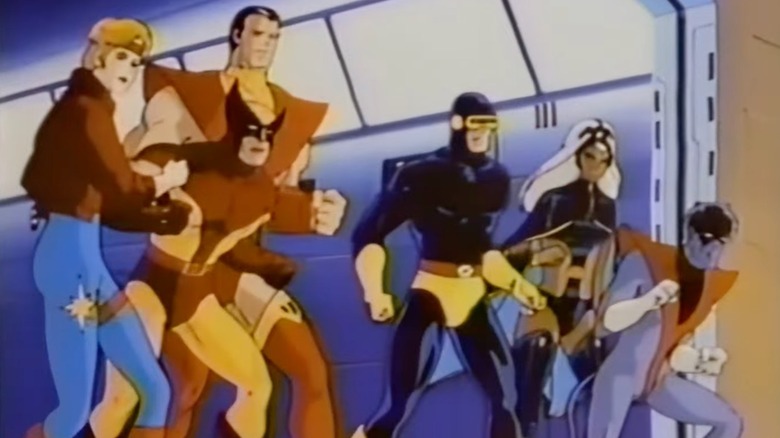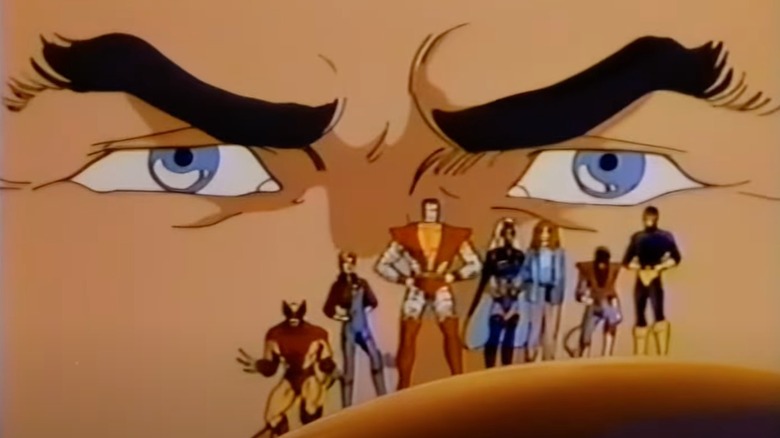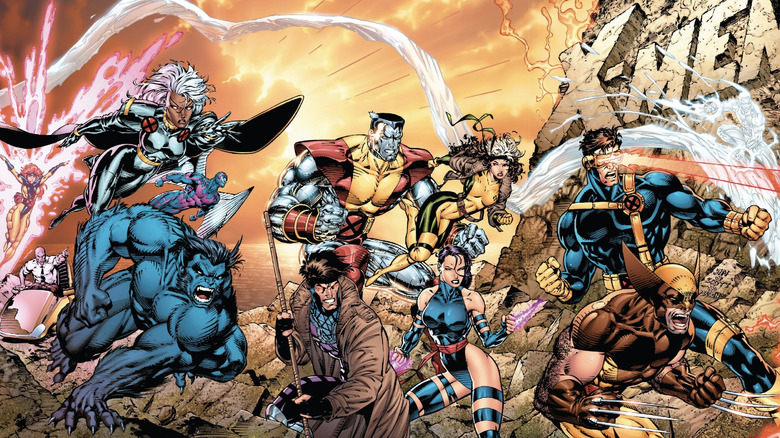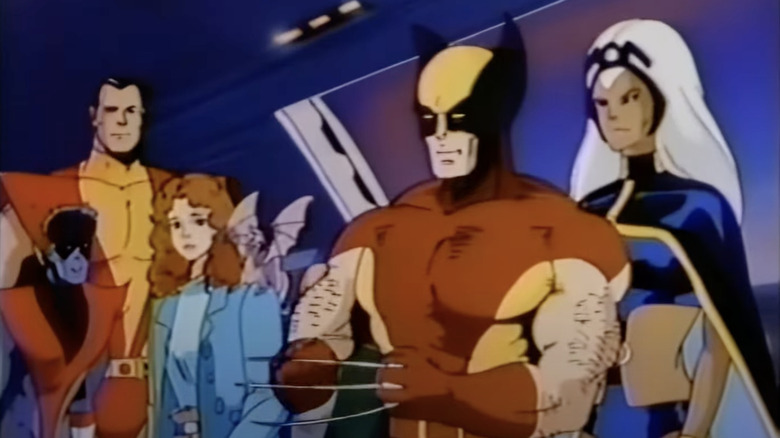The First Animated X-Men Show Never Made It Past The Pilot Stage
1992's "X-Men" cartoon was the first time Marvel's Merry Mutants got a series all of their own, but was it the first time they appeared in animation? Not quite.
The team were guest stars on the early 1980s series "Spider-Man and His Amazing Friends" (said friends were Iceman and Firestar, former members of the X-Men), as was their nemesis Magneto. A few years down the line, Marvel Productions decided to produce an "X-Men" cartoon themselves.
The resulting pilot was "Pryde of the X-Men" (named for Kitty Pryde, the teenage X-girl who can walk through walls). "Pryde" boasted animation from Japanese studio Toei ("Dragon Ball Z"), and so looked noticeably more detailed and dynamic than previous Marvel cartoons. Where it did overlap with those older cartoons was the voice cast: the late John Stephenson as Professor X, Michael Bell as Cyclops, Neil Ross as Nightcrawler, Dan Gilvezan as Colossus, and a young Kath Soucie as Kitty.
Patrick Pinney, as Wolverine, infamously gives his character an Australian accent (apparently a synergistic holdover from a to-be-canceled Wolverine movie). On the villainous side, Earl Boen (Dr. Silberman from "Terminator") was Magneto, and Skeletor himself, Alan Oppenheimer, was the Blob.
The pilot was meant to kick off a 65-episode syndicated series, produced in synergy with an "X-Men" toyline. While "Pryde" was broadcast in 1989 and even released on VHS, it was not picked up for more episodes. It's ultimately remembered as both the basis of the Konami X-Men arcade game and a beta test for the 1992 series; several of the "X-Men" creative team, such as executive Margaret Loesch and animators Larry Houston and Will Meugniot, had previously worked on "Pryde." How does "Pryde of the X-Men" compare with the eventual "X-Men" cartoon? Does it deserve to be considered as more than a footnote?
Plot of 'Pryde'
"Pryde of the X-Men" itself is pretty simple stuff, about as sophisticated as you'd expect from a 1980s action cartoon (not very).
There's a title sequence, complete with a lyrical song, though the video is all just sampled from the episode itself. Interestingly, this opening uses a title card that simply says "X-Men" (in the same bold font used by the comics and the 1992 cartoon). It should be noted that "Pryde of the X-Men" is the name of the pilot itself — if it went to series, there's a good chance that show would've just been called "X-Men."
The episode, written by Larry Parr and narrated by Stan Lee, features Kitty joining the X-Men as they square off with Magneto and the "Brotherhood of Mutant Terrorists." The young Kitty acts as the audience's POV character, learning about this strange world of superpowers as the viewer does.
The episode opens with an imprisoned Magneto being transported in a military convoy before he's freed by Emma Frost/The White Queen. Meanwhile, Kitty arrives at Xavier's school and meets the Professor. The X-Men are introduced, one by one, training in the Danger Room, their Holodeck-esque training center. Introductions don't last long because Magneto attacks and steals a power cell from supercomputer Cerebro. His plan is to knock a passing comet toward Earth, hoping to create a second Ice Age from the impact and rule from his orbital base, Asteroid M.
The X-Men follow Magneto to Asteroid M and defeat the Brotherhood in successive one-on-one battles. They foil the villain's plan, though he escapes, and destroys Asteroid M by diverting the comet to it (Nightcrawler stays behind to guide this and teleports out just in time). From there, the heroes fly off into the horizon for future adventures that never came.
Different X-Men eras
Meugniot feels "Pryde" failed because it tried to introduce too many characters too quickly. He'd wanted to use the robotic Sentinels as the villains, explicitly to keep the focus on the X-Men, but the powers that be wanted all the villain toys (i.e. the Brotherhood) to debut first. Indeed, when he got a second chance at the bat, he used his rejected pitch as the basis for the 1992 "X-Men" Pilot: "Night of the Sentinels."
One of the most obvious differences between the two shows is the X-Men themselves. "Pryde" is modeled on the late 70s-80s X-Men; the team line-up (Cyclops, Storm, Wolverine, Nightcrawler, Colossus, Dazzler, and Kitty) reflects most of the X-Men mainstays during that decade, as do their costumes. The cast of "Pryde of the X-Men" looks like they were drawn by Dave Cockrum ("Giant-Size X-Men" #1) himself (check out unearthed model sheets and artwork for "Pryde" here).
In the same manner, the 1992 X-Men looked ripped (almost) right off the page of Jim Lee's cover art for the best-selling 1991 relaunch, "X-Men" #1. Professor X, Cyclops, Jean Grey, Storm, Beast, Rogue, and Gambit's designs in the cartoon are all Lee's own. As for Wolverine, Lee soon had him trade in his brown-shaded outfit (as seen in "Pryde") for his original yellow-and-blue (from issue #4 onward). So, the yellow-and-blue costume is what Logan had in the 1992 cartoon. But I digress.
Jubilee, who by the 1990s was the new "rookie X-Girl," also took Kitty's place in the 1992 cartoon. In fact, the so-called pride of the team never showed up in the latter series.
Two very different shows
Compared to "Pryde," the 1992 "X-Men" is more naturalistic. Using that word to describe such a flashy and bombastic show might sound crazy, but it comes down to the X-Men themselves.
In the 1992 show, the characters talk and feel more like real human beings, with interior lives and thoughts beyond being superheroes. In "Night of the Sentinels," Jubilee first meets Storm and Rogue when they're at the mall, shopping and dressed in normal clothes. When Wolverine later needs to blow off steam, he goes to a bar and plays some pool. As an isolated story, "Pryde" has only a few traces of characterization; Kitty overcomes her fear of Nightcrawler's demonic appearance and accepts him as a friend, while Wolverine gets over his standoffishness and concedes that Kitty might make it as an X-Men after all.
The dialogue in "Pryde" is also stilted and over-describes (though this might just be because of all the exposition it has to dispense). It actually winds up semi-resembling the verbose, melodramatic writing of "X-Men" Chris Claremont, minus the literary flair, humor, and sensuality that elevate his stories.
In short, the two cartoons are products of their time; like many kids' shows of the 80s, "Pryde" is both so earnest and weird that it becomes camp. The 1992 "X-Men," though, is all about being edgy and cool. Compare the cheesy theme song composed for "Pryde" to the rousing instrumental opening of the 1992 show.
A remastered official release of "Pryde" probably isn't forthcoming, though low-quality scans still exist. While not spectacular on its own terms, it makes for an entertaining historical footnote.



